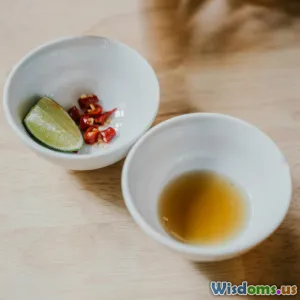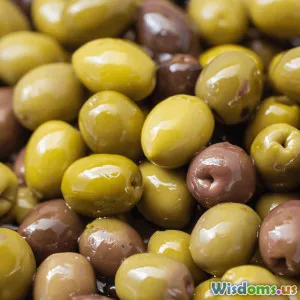
The Science Behind Umami and How to Enhance It in Your Dishes
7 min read Explore the science of umami and practical tips to deepen its flavor in your cooking. (0 Reviews)
The Science Behind Umami and How to Enhance It in Your Dishes
Have you ever wondered why certain dishes just taste better? That savory depth that lures you back for seconds, the flavor that's more than salty, sweet, sour, or bitter — that’s the magic of umami. Recognized as the fifth basic taste, umami has reshaped culinary science and cooking culture worldwide. But what exactly is umami? How does it work on a molecular level, and more importantly, how can you elevate it in your kitchen? This article uncovers the secrets behind umami and offers practical tips to enhance it in your dishes.
Understanding Umami: More Than Just Savory
Though the Japanese named it in 1908 — from uma (delicious) and mi (taste) — umami's roots are deeply scientific and universal. Unlike the crisp sharpness of sour or sweetness of sugar, umami provides a lingering mouthfeel that delivers fullness and satisfaction.
The Chemistry Behind Umami
Umami arises from the presence of free glutamates and certain nucleotides, primarily L-glutamic acid, inosinate, and guanylate. When these molecules bind to specific receptors on our tongue — mainly the T1R1/T1R3 umami receptor — an intense savory sensation fires off.
Think of monosodium glutamate (MSG), the most famous umami enhancer. Its sodium salt form appears naturally in many foods and is widely used to evoke umami without overpowering other flavors. In fact, MSG’s safety and culinary properties have been extensively studied and affirmed by authorities like the FDA and WHO.
The Role of Nucleotides
Pure glutamate evokes umami on its own, but the experience intensifies dramatically with nucleotides like inosinate (commonly found in meat and fish) and guanylate (common in mushrooms). This synergistic effect explains why certain ingredient pairings — such as combining tomatoes with Parmesan or anchovies with olives — taste so compelling.
Rich Sources of Umami in Your Pantry
Umami is naturally abundant in a variety of ingredients across global cuisines.
- Aged Cheeses: Parmesan, Roquefort, and aged cheddar are rich in glutamates.
- Tomatoes: Especially dried and sun-dried, packed with free glutamates.
- Mushrooms: Shiitake and porcini, loaded with glutamates and guanylate.
- Seafood: Anchovies, sardines, dried fish, and bonito flakes are classical umami boosters.
- Soy Sauce and Miso: Fermented products packed with glutamates and nucleotides.
- Cured Meats: Prosciutto and other dry-cured meats concentrate umami.
- Broths and Stocks: Slow-simmered bone or vegetable stocks release umami compounds.
How to Boost Umami in Your Cooking
Now that we’ve delved into the science, here’s how to put it into practice and turn your dishes into umami powerhouses.
1. Combine Complementary Umami Ingredients
Exploit the synergy between glutamate-rich and nucleotide-rich ingredients. For example:
- Add dried shiitake mushrooms and a splash of soy sauce to soups.
- Use Parmesan rind to enrich vegetable stocks.
- Blend anchovies into tomato-based sauces — the fishiness melts away, leaving intense savoriness.
2. Embrace Fermentation and Aging
Processes like fermenting soybeans to make miso or aging cheeses increase free glutamates. Incorporate these into marinades, dressings, or sprinklings on grilled foods to add complexity.
3. Use Umami-rich Condiments and Powders
Condiments such as fish sauce, oyster sauce, tamari, and umeboshi (Japanese pickled plums) offer intense savoriness. Umami-rich powders made from dried seaweed or mushrooms can elevate ramen or roasted vegetables.
4. Rethink Cooking Techniques
- Roasting and caramelizing vegetables like onions and tomatoes increase glutamate concentrations through Maillard reactions.
- Slow simmering stocks helps extract umami compounds from bones and vegetables.
- Toasting dried ingredients like mushrooms before adding them to dishes can amplify umami flavors.
5. Hydrolyze Proteins
Isolating the free amino acids in protein-rich ingredients maximizes umami. For instance, using enzymatic hydrolysates such as soy protein hydrolysate (found in some seasonings) boosts umami.
Real-World Applications and Culinary Impact
Umami in World Cuisines
Umami is a silent hero behind countless global dishes:
- Japanese: Dashi, made from kombu (kelp) and bonito flakes, is a defining umami broth.
- Italian: Umami saturates classic pasta sauces, risottos, and aged cheese-laden dishes.
- French: Slow-cooked stocks and reductions where beef marrow and mushrooms nourish umami intensity.
- Korean: Fermented pastes (doenjang), fermented fish sauces, and aged kimchi elevate umami in stews.
Scientific Insights into Consumer Preferences
Research published in the journal Frontiers in Nutrition (2019) highlights that umami not only enhances flavor but can stimulate salivation and increase appetite, improving meal satisfaction and even assisting in sodium reduction by providing fullness with less salt.
Umami as a Health Ally
While some worry about MSG, extensive research confirms its safety within normal dietary usage. Moreover, dishes rich in umami can contribute to balanced, wholesome eating by enhancing taste without excessive fat or sugar.
Conclusion
Umami is more than just a taste—it's an intricate sensory experience rooted in chemistry and culture. By understanding how umami works and how ingredients interact, you can elevate your cooking, impressing friends and family with richer, deeper flavors. So next time you cook, think umami: experiment with complementary ingredients, embrace fermentation and aging, and explore innovative techniques that boost savoriness. The delicious science of umami awaits your kitchen mastery.
Unlock umami's secret, and transform every meal into a memorable feast.
Rate the Post
User Reviews
Popular Posts



















